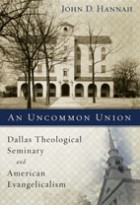 John Hannah, Research Professor of Theological Studies and Distinguished Professor of Historical Theology at Dallas Theological Seminary, has now written the first institutional history of Dallas Theological Seminary: An Uncommon Union: Dallas Theological Seminary and American Evangelicalism (Zondervan, 2009). He was kind enough to offer these candid answers to my questions.
John Hannah, Research Professor of Theological Studies and Distinguished Professor of Historical Theology at Dallas Theological Seminary, has now written the first institutional history of Dallas Theological Seminary: An Uncommon Union: Dallas Theological Seminary and American Evangelicalism (Zondervan, 2009). He was kind enough to offer these candid answers to my questions.
What are the advantages and disadvantages of an “insider” writing an institutional history?
The difficulty faced in writing contemporary history is that prejudice cannot be filtered by the process of time. Therefore, there is a lack of perspective. Also, people are living so that some things that should and ought to be said cannot. Further, people seek to persuade you from their perspectives. These factors, and others, dull the objectivity of the task.
 The advantage, of course, is that the availability of eyewitnesses with insightfulness that is often lost with the passage of time.
The advantage, of course, is that the availability of eyewitnesses with insightfulness that is often lost with the passage of time.
Why is the relationship between DTS and American evangelicalism an “uncommon union”?
What is “uncommon” about the union of DTS and Evangelicalism is that the seminary does not fit in any of the standard definitions. It is a school that carved out its own tradition by eclecticism.
We are fundamentalistic without embracing some tenants of Fundamentalism, such as secondary separationism; we are evangelical, but not mainstream in some ways. We, at least historically, are Augustinian in soteriology, Plymouth Brethren in eschatology and millennial perspective, and we are mildly Keswick in sanctification theory. Warfield called Chafer confused and I think that has some merit. The seminary is “confused” theologically if combining things not traditionally combined is the meaning of confusion. The seminary reflects its Bible Conference roots in the nineteenth and early twentieth centuries of transdenominationalism and eclecticism.
Your book is organized around the five presidents of DTS. In what ways did each of them leave their mark on DTS as an institution?
I organized the book around the five presidents because of their unique contributions in the direction of the school.
Lewis S. Chafer (1924-1952) established the vision of the school around a passion for Bible teaching and evangelism. Theology served those ends.
John F. Walvoord (1952-1986) allowed the school to adopt the color of his emphases and specialty. That is, under Walvoord the school experienced a shift of emphasis to encompass eschatology. Under Walvoord, the school emerged as a significant institution but became known for its eschatology, for good or for ill.
Donald K. Campbell (1986-1994) had the difficult task of guiding a seminary after the tenure of a dominant administrator in the midst economic crisis, turmoil in the faculty, and a declining student body. His unique contribution was that he tried to bring the school into the mainstream of Evangelism, eschewing the appearance of rigidity, without changing the school’s original theological commitments for the faculty, though he did broaden theological tolerance in the student body.
Charles R. Swindoll (1994-2001) delivered the school from an economic downturn and greatly increased the student body. He reversed the numbers from the Campbell era. He was not successful in making the seminary more narrowly focused and less diversified.
Mark L. Bailey (2001-present) is the most astute administrator/ leader of the school since Walvoord. It is too early to know whether he is leading the school or maintaining it. He faces a world that is postmodern; the other presidents did not have some of his challenges.


















